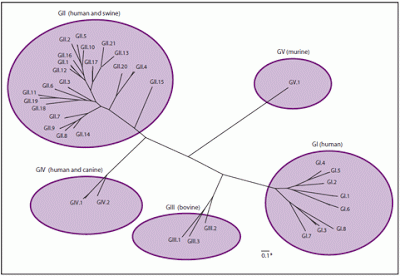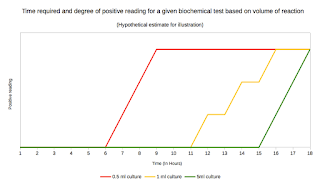Norovirus
Hello,
I have been for a long time thinking to write about a common pathogen- Norovirus. Without going into too much of research, here i just want to put up a few facts and figures of potential interest. Let me begin the post more vaguely.
 |
| Fig 1: Prevalence of Food-borne illnes. Source |
Gastroenteritis is a common problem in various parts of the world. What is this gastroenteritis? Gastroenteritis refers to a condition that causes irritation and inflammation of the stomach and intestines or more reasonably, the GI tract. Several series of infectious agents can cause gastroenteritis. It can be bacterial (examples include E coli, Salmonella, Campylobacter), Parasitic (examples include Giardia, Cryptosporidium), Fungal (Common agent is Candida) or viral. The viral agents involved with Gastroenteritis belongs to 4 families: Reoviridae (Rotavirus), Caliciviridae (Norovirus and Sapovirus), Astroviridae (Astrovirus), and Adenoviridae (Adenovirus). Irrespective of etiology it is commonly seen that children aged under 2 years are the most vulnerable to viral gastroenteritis worldwide. Rotavirus is implicated in most of the cases of children below 5 years. But in case of adults, it is the Norovirus that predominates. Another interesting fact is that the bacterial gastroenteritis is common in developing countries while Viral type is common in developed countries.
 |
| Photo 1: Norovirus. Source |
Norovirus (Previously known as Norwalk virus, also know by several other names such as winter vomiting bug!!!) was first first discovered in an outbreak at Norwalk, Ohio. Hence the name. The virus is a non enveloped 27 nm particle with icosahedral symmetry of capsid. being a member of Caliciviridae the genome is + ssRNA (genome of ∼7.5 kb), with a Vpg protein at 5' end. Each virus particle is composed of 180 molecules of the capsid protein (T=3), forming 90-arch-like capsomers at all the local and strict twofold axes surrounding the hollows. The capsid protein folds into two principal domains, a shell (S) domain and a protruding (P) domain, which contains two subdomains, P1 and P2. The genetic organization of this virus is simple. RNA organized into 3 open reading frames (ORFs). ORF1 encodes nonstructural proteins such as RNAdependent RNA polymerase, ORF2 encodes viral capsid protein 1, and ORF3 encodes a small capsid protein (viral capsid protein 2) associated with stability of viral capsid protein 1 (Reference). Based on capsid phylogenetic analysis, the virus was classified into 5 major genotypes- GI to GV. These genotypes are cluster of various types which can be subdivided accordingly.
 |
| Fig 2: Classification of Norovirus genotypes by phylogenetic analysis. Source |
Based on several set of studies the most common genotype associated with human infections were postulated to be GII.3 or GII.4 (Farmington Hills strain). Type GII.3 is possibly more aggressive in nature, and known to cause necrotising enterocolitis (Reference).
Norovirus, is one of the leading cause of viral gastroenteritis especially in adults. The infection caused is also know as cruise ship disease or stomach flu. Of the most recent am aware of, an outbreak was in Everett (largest city in Snohomish County, Washington, United States) with count of infected people was 229 atleast (Read the story here).
The Study of pathogenesis of Norovirus has been complicated due to lack of a proper cell culture system. Most of the recent data comes from growing the virus in Huh-7 (Human Hepatoma Cell line) and 3D INT-407 cell line (Reference). 3D INT-407 cell line is a Human Negroid cervix carcinoma cell line originally isolated from the jejunum and ileum of a 2 month old Caucasian embryo. The cells have a similar virus susceptibility as HeLa but show less sensitivity. They carry HeLa marker chromosomes. This cell line has been found to be indistinguishable from HeLa by STR PCR DNA profiling. Therefore, the cells must be considered as derived from HeLa (Source). The cell infectivity assays for Norovirus is done by using this cell line which is commercially available as CCL6 cell line. Mouse Norovirus can be grown inside dendritic cells and macrophages, which can be used as a model to study the biology.
The entry receptor and the mechanism of virus entry has not been clear to date. The bulk of evidence suggest that the virus P domain (Most possibly P2 subdomain) has significant binding properties to human histoblood group antigens (HBGAs). However, the HBGAs represent a very complex system and the type involved is strain specific. It is but more commonly agreed thatR cluster (Arginine rich region within P domain) which is highly conserved is essential for receptor attachment. Much of the details in replication is unknown. The virus replicates in the enterocyte cytoplasm.
So much so about the biology. The virus is transmitted through contaminated food and water. The virus is shed for almost 2-3 weeks after the symptoms appear and is highly resistant to environmental factors, providing good transmission index. The virus is also famous for its high contagious nature. Most of the food quality control looks for bacterial and parasitic contamination and hence this virus can easily escape attention. The infection presents itself as a non specific fever and abdominal pain, and most often profuse diarrhea leading to dehydration. The symptoms usually manifest by 48 hrs of infection, though 1/3rd of the infected population are asymptomatic.
 |
Photo 2: IDEIA kit, ELISA method
for Norovirus. Source
|
The choice of method for diagnosis include electron microscopy, reverse transcription-polymerase chain reaction, real time reverse transcription-polymerase chain reaction, nucleic acid sequence-based amplification and enzyme immunoassay detection using a commercial kit (example IDEIA kit). Electron microscopy has the disadvantage that there should be atleast 106 per ml of stool. This makes other molecular method such as PCR based reactions more desirable in a clinical laboratory. For sero-prevalence immune adherence hemagglutmation assay (IAHA) is used commonly.
That brings me to the most researched area of Norovirus. Vaccine!! Vaccination is the ultimate possible method to control any infectious agent over a large geographical distribution. The most important hurdle to make a vaccine is the variety of types that is in nature and high variability. To date many different strategies to make a vaccine has failed. But then newer strategies are emerging and some of them are in clinical trials, such as the one by LigoCyte.
The LigoCyte uses a Norovirus Virus-Like Particle (NVLP). This is capsid protein only particle (void of the genetic material for replication and infection), given with MPL adjuvant. Administration of Norwalk virus VLPs to people by the oral or intranasal route produced measurable serum antibody responses. In the current clinical trial by LigoCyte intramuscular is also explored as an option. The preparation of vaccine involves removing a gene from norovirus that codes for its protective protein coat and inserted into a common tobacco virus. When the virus infects tobacco plants and multiplied inside their cells. This produces thousands of copies of the norovirus protein, which assemble into virus-like particles. Currently, nasal spray is the preferred mode of administration with best effects.
A yet another paper published a couple of days ago, has tried to use a dual component. Both the leading etiological factors- Rotavirus (RV) and norovirus (NoV) was targeted in a single vaccine. The study showed that IgY (Egg yolk immunoglobulin) could be produced in chickens by immunisation with a dual antigen which consists of P from Norvovirus and Vp8 (Spike protein) from Rotavirus.
The best said approach is to maintain a good hygiene and eat well cooked food only. But, when it comes to washing, a recent report in PLoS One (Link) suggest that, good washing protocols are not sufficient to get rid of this virus. This experiment was conducted using Murine Norvovirus, but probably, the data is comparable. Perhaps, we should raise our hygiene standards.
Dai YC, Zhang XF, Tan M, Huang P, Lei W, Fang H, Zhong W, & Jiang X (2012). A Dual Chicken IgY Against Rotavirus and Norovirus. Antiviral research PMID: 23267830
Atmar RL, & Estes MK (2012). Norovirus vaccine development: next steps. Expert review of vaccines, 11 (9), 1023-5 PMID: 23151158
Further Reading:
1. Straub etal. In Vitro Cell Culture Infectivity Assay for Human Noroviruses. Emerging infectious diseases. 2007 March; 13(3): 396–403. Link
2. Robert L. Atmar and Mary K. Estes. Diagnosis of Noncultivatable Gastroenteritis Viruses, the Human Caliciviruses. Clin Microbiol Rev. 2001 January; 14(1): 15–37. Link
3. Feliciano L, Li J, Lee J, Pascall MA (2012) Efficacies of Sodium Hypochlorite and Quaternary Ammonium Sanitizers for Reduction of Norovirus and Selected Bacteria during Ware-Washing Operations. PLoS ONE 7(12): e50273. doi:10.1371/journal.pone.0050273. Link




